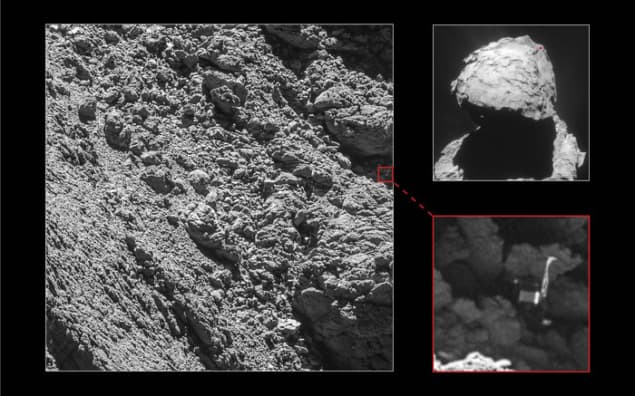Flash Physics is our daily pick of the latest need-to-know developments from the global physics community selected by Physics World‘s team of editors and reporters

Philae lander spotted on comet 67P at long last
Nearly two years after it bounced onto the alien surface of comet 67P/Churyumov–Gerasimenko, Rosetta scientists have managed to locate the “final resting place” of their Philae lander, in images taken by Rosetta’s high-resolution camera. This news could not have come at a better time for the European Space Agency team as the mission is less than a month away from its end. As the picture above shows, Philae is wedged into a dark crack on the comet and the instrument’s orientation clearly reveals why establishing communications was so difficult, following its landing on 12 November 2014. The images were taken on 2 September by the OSIRIS narrow-angle camera, as Rosetta came within 2.7 km of the surface. You can read more about Philae’s tense and exciting first few days on 67P in our previous news stories and blogs.
Scientific, state and film royalty mingle at Kavli Prize ceremony
Winners of the 2016 Kavli Prize in Astrophysics will receive their awards today from Norway’s Crown Prince Haakon in a ceremony in Oslo, Norway. The physics prize was awarded to Ronald Drever, Kip Thorne and Rainer Weiss for the direct detection of gravitational waves. In February, scientists working at the US LIGO detectors in Washington and Louisiana announced they had directly measured gravitational waves for the first time. The US actor Alan Alda and the Norwegian actress Lena Kristin Ellingsen will host the ceremony. The Kavli Prize consists of a $1m prize with the laureates also receiving a gold medal and a scroll.
Diamond Light Source unveils new electron-microscopy facility
A new electron Physical Sciences Imaging Centre (ePSIC) was opened yesterday by the Diamond Light Source in the UK, together with the University of Oxford and the chemicals company Johnson Matthey. Located on the Harwell campus in Oxfordshire, the facility will contain two state-of-the-art electron microscopes that can record information at a rate of up to 200 frames per second, and will allow scientists to actually “see” and analyse individual atoms, within materials, in real time. Andrew Harrison, CEO of the national synchrotron science facility, called this “the most significant day” for Diamond in 10 years, in terms of launching new facilities. Each room in the new facility is carefully isolated from vibrations, is soundproof and has anti-echo walls, and is temperature-controlled to within 0.1 °C, reports Physics World‘s Margaret Harris, who attended the launch. Also of note is that each electron microscope has its own miniature electron accelerator – capable of generating the 100 keV electrons used for imaging – rather than using electrons from the Diamond beamline.
Novel superconductor wins EU SOFT Innovation Prize
The €50,000 EU SOFT Innovation Prize for fusion research has been awarded to researchers at the Karlsruhe Institute of Technology (KIT) and the Swiss Plasma Center (SPC). The prize was awarded yesterday at the 2016 Symposium on Fusion Technology (SOFT) in Prague. KIT researchers designed a new superconducting concept that might be used as a basic element in future high-current cables of fusion power plants, industrial facilities or DC power grids. Sustainable-energy sources and, above all, the reliable distribution of energy are major elements of [Germany’s Energy Transition],” says Holger Hanselka, president of KIT. “The prize reflects KIT’s essential contribution to research, to the transformation of the energy system, and to the viability of our society.”
- You can find all our daily Flash Physics posts in the website’s news section, as well as on Twitter and Facebook using #FlashPhysics. Tune in to physicsworld.com later today to read today’s extensive news story on when the first stars formed in the universe.



